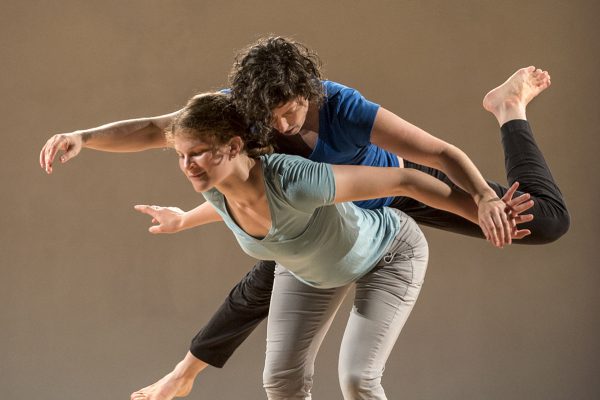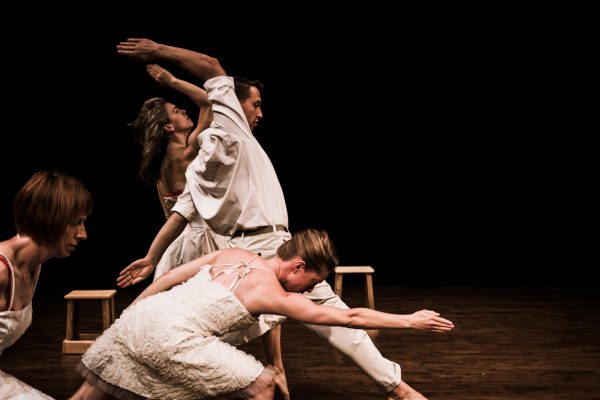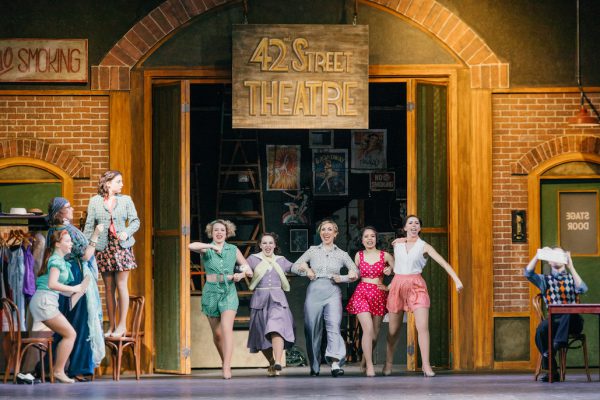When you purchase music, you pay for the right to use that music in private. Once you enter the public sphere, as a performer, creator or instructor, you are liable for the fees associated with the public use of music, as awarded by the Copyright Board of Canada, the independent government body charged with administering copyright claims and tariffs.
Rights Collective
According to the Copyright Act, any public performance of copyright protected musical works requires a license. SOCAN and Re:Sound are copyright collectives, bodies empowered by the Copyright Board of Canada to represent certain legal rights and interests and thereby collect and redistribute the fees obtained through licenses.
SOCAN
• Represents songwriters, composers, lyricists and music publishers (copyright).
-
This not-for-profit company was formed in 1990 from former rights collectives that have been around, in some form, for over eighty years.
- It collects license fees relating to live performance of members’ works.
Re:Sound
• Represents recording artists or record companies who own the rights to the recording of songs (neighbouring rights).
-
It was established in 1997 as the Neighbouring Rights Collective of Canada (NRCC) and renamed Re:Sound in 2010.
-
Re:Sound only licenses recorded music.
The differences between the two organizations lie not in where or when music is used but in who is entitled to compensation for that use. That is, both SOCAN and Re:Sound have some tariffs that cover similar uses (such as for background music or fitness). If the fees were applicable, you might have to pay both SOCAN and Re:Sound for the same single use or event, as the same recording might be subject to both copyright and neighbouring rights claims.
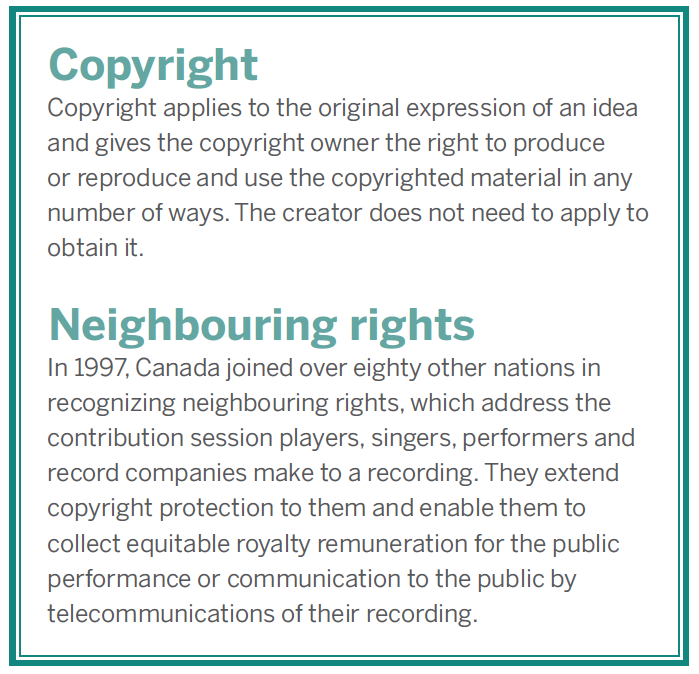
Fair dealing
The Fair Dealing Exceptions allow copyrighted material to be used under specific circumstances for particular purposes, including research or private study, criticism or review, news reporting and reproduction or performance for educational purposes (part of the curriculum). Fair dealing is assessed on a case-by-case basis from a (fairly long) list of questions regarding the usage.
Fun fact: Librarians are often very well versed in Fair Dealing policy. They are good people to ask about this topic.
Fun fact: Librarians are often very well versed in Fair Dealing policy. They are good people to ask about this topic.
If you are unsure, consult the Canadian Copyright Act >> cb-cda.gc.ca.
Why does it feel like I suddenly need to pay Re:Sound Fees (when I didn’t have to pay them before)?
The right to collect license fees for neighbouring rights was awarded to Re:Sound (then NRCC) in 1998. To collect fees they must have their tariffs approved by the Copyright Board of Canada, which is notoriously slow. NRCC applied in 2008 but the tariffs were only approved in 2012. From that point, Re:Sound was in a legal position to collect license fees, backdated to the time of application in 2008.
Why should I pay these fees?
There are critics of the rights collectives and their fees. Objectors point to the large number of rights holders for most recorded music, with only a small percentage of the fee returning to the artists. There are also concerns about the negative consequences for the artistic milieu of adding to the financial burden of creation and presentation.
But, as Frédérick Julien, director of research and development at the Canadian Arts Presenting Association (CAPACOA) explains, musicians and musical producers are part of the same artistic environment as other artists. “The right holders represented by Re:Sound,” explains Julien, “are part of the same cultural ecosystem as you.” Compliance with the fee system is one step in supporting the economic rights of artists.
Good to know
Older (can be) cheaper: The public domain
Works considered to be part of the public domain require no licenses for their use. Recordings are considered public domain when they are more than fifty years old. Musical works are public domain if the last living composer or author has been dead for fifty years or more. For a recording, both conditions (neighbouring rights and copyright) would have to be met for there to be no applicable fees.
Calendar year
Fees are based on the calendar year, not fiscal or season.
Performance
When using music for a dance performance, be sure to investigate the applicable fees and who holds the copyright for any material used during pre-production, though the fees are not due until after the performance. Retain any evidence of your communications or attempts at communication with copyright holders for your records.
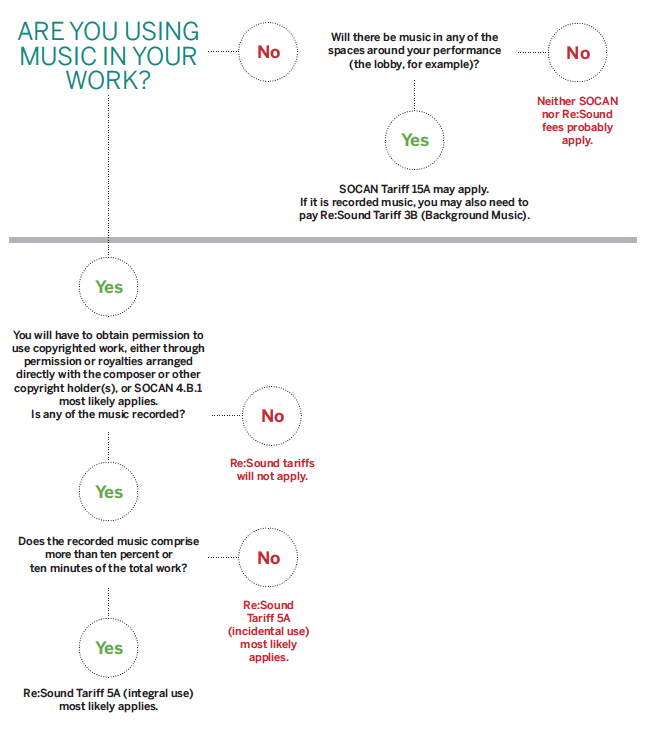
SOCAN
The most common SOCAN tariff for the use of music during a dance performance is 4.B.1 (Classical Music Concerts), allowing the use of any music in SOCAN’s repertoire. It is usually calculated based on ticket sales with a minimum fee of $35. Pre- show, intermission and post-show use of music (Tariff 15A) is calculated based on the size of the facility and allows for any song in the SOCAN repertoire to be played.
Re:Sound
The most common Re:Sound tariff for the use of recorded music during a dance performance is Tariff 5A (Recorded Music Accompanying Live Entertainment). It was previously known as 5K and is awaiting Copyright Board approval but will be applicable as of 2015. Within 5A there are incidental use licenses, in which recorded music is used for less than ten percent or less than ten minutes of the work, and integral licenses, for more than that amount.
Both the incidental and the integral fee of Tariff 5A are blanket fees and cover any smaller applicable fees. For example, a Tariff 5A also confers the right to use music as background music (which is a lesser fee).
Some other situations
-
Any recognizable use of a musical work, humming a known song, for example, could be subject to copyright (though Re:Sound would not apply if it is not recorded). There could, however, be fair dealing exceptions.
-
If you commission music, the copyright most likely rests with the composer. The commission contract should specify the details for productions and future performances (whether remounts and tours are included). Otherwise, the work could be subject to owner’s copyrighted use.
-
For music improvised during a performance, the copyright would rest in the “performer’s performance.” Beyond agreements for the production and use during the performance, as laid out in a contract with the musical artists, no further copyright fees would usually apply unless that exact composition and performance was used or circulated subsequently.
-
Music used during closed rehearsals would usually be considered a private usage, and consequently not subject to tariffs, as the participating artists would be considered staff or contract workers, not customers.
Effects on practice
Going forward with Re:Sound’s dichotomy between incidental and integral usage (more or less than ten percent or ten minutes of a work), creators of new dance works and their presenters may want to think about the significance of that threshold in deciding to use recorded music in their work, to avoid moving from the incidental to the integral categories for only a small amount of time or content.
Teaching
In many cases, the Fair Dealing Exception covers the use of music used in an educational setting but does not apply to teaching for profit (in a paid dance studio setting, for example). Dance recitals in an educational setting with no paid admission would be exempt from SOCAN and Re:Sound fees, but a public event, with paid admission, would be subject to fees, even if that event was held in a school or privately owned studio.
SOCAN
Using music for dance purposes falls under SOCAN Tariff 19 (Fitness Activities and Dance). The fee is based on the number of participants in the room per week averaged over the course of the year. In Ontario, Dance Ontario has a group licensing agreement of $64 per year for individual teachers, which allows them to teach in multiple sites.
Re:Sound
For adult dance lessons and for-profit teaching, Tariff 6.B (Physical Activity) would most likely apply. Unlike SOCAN Tariff 19, it covers only the teaching of dance, fitness or skating, not any background use in the same fitness environment, which would be covered by Re:Sound’s Tariff 3.
Contracts
As a choreographer, performer or teacher, it is in your best interest to ensure that responsibility for both SOCAN and Re:Sound fees is clearly stated in your contracts. Dance service organizations have detailed online tools and resources for building contracts.
- There is joint liability for licensing fees between all parties in the presentation, and that liability is not clearly identifiable. It is assessed on a variety of factors including who has access to recording and ticketing information, admissions data and who appears to be most instrumental in providing the recorded music for the end user.
- When creating contracts, consider who, among the liable parties, has the greatest fluency and ease with the licensing systems. In many cases, the venue is the logical party to hold responsibility, but not in all instances. In any event, responsibility should be clearly laid out.
A helpful hint from Frédérick Julien
With the forthcoming Re:Sound 5A fee, most artists and presenters will not exceed the minimum payment threshold unless they have a very large attendance. It is often in the licensee’s interest, therefore, to pay their fee based on the total attendance number, not the per event fee, in which case, it is usually more economically beneficial to roll the tariffs into one larger license fee, for the venue as a whole, for example.
Yes, but …
To confirm the required fees or to ask about conditions specific to your creation, presentation or teaching situation, please consult directly with the appropriate organization’s licensing department:
Re:Sound
resound.ca
877-309-5770
licensing@resound.ca
SOCAN
socan.ca
866-944-6223
licence@socan.ca
This article is for informative purposes only and does not constitute legal advice.
Thank you to the following for resources and information: Rosslyn Jacob Edwards (Dance Ontario), Frédérick Julien (CAPACOA), Martha Rans, Jessica Wadsworth (CADA/West) and Theatre Ontario.
Thank you to the following for resources and information: Rosslyn Jacob Edwards (Dance Ontario), Frédérick Julien (CAPACOA), Martha Rans, Jessica Wadsworth (CADA/West) and Theatre Ontario.
This article was originally published in the July/August 2016 issue of The Dance Current.
Tagged: copyright, licensing, Multidisciplinary, music, Performance, Re:Sound, SOCAN, Teaching, All
